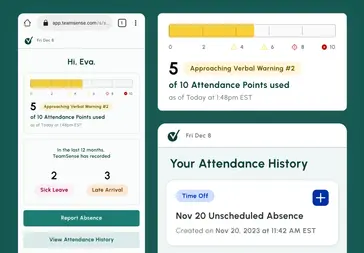Fix the root cause of No-Call No-Show with help from TeamSense
Table of Contents
- Quick Breakdown of Point System Attendance Policy
- The Evolution of Attendance Tracking Technologies
- The Benefits and Challenges of Point System Attendance Policies
- Planning Your Point System Attendance Policy
- Different Approaches to Rolling out a Point-Based Attendance Policy to Employees
- Tracking Attendance Points Once The Policy Is Set
- Implementing Your Point System with TeamSense
- How to Write Your Point System Attendance Policy
- Example of a Point System Attendance Policy
- Managing and Refining Your Policy Over Time
- The Role of TeamSense in Modernizing Attendance Policies
Reading about point system attendance policies might sound as thrilling as watching paint dry, but stick with me—I promise it’s more interesting than it sounds. As we approach 2025, with the fabric of our workforce evolving rapidly, the spotlight turns unexpectedly towards those who clock in daily at their physical workplaces. For hourly employees in warehouses, retail, casinos, and even those ensuring our favorite baseball games go off without a hitch, being physically present isn't an option—it's a requirement.
For these vital sectors, implementing an effective point system attendance policy goes beyond mere benefit—it's a cornerstone of operational success. It's about ensuring that every team member, those we rely on to keep the gears of commerce and entertainment turning, receives equitable treatment and clear communication regarding attendance expectations and where they stand within those expectations.
As we dive into the nuts and bolts of creating, applying, and fine-tuning a point system policy tailored for the unique challenges faced by these indispensable workers, we'll uncover how point system-based attendance policies can significantly reduce absenteeism, promote fairness, and elevate morale and attendance accountability. By the end of this article, you'll see that a well-designed point system is more than just administrative red tape; it's a strategic tool that can transform your workplace dynamics.
Quick Breakdown of Point System Attendance Policy
As workplaces evolve, the way we view time and attendance at work is shifting. Point system attendance policies are at the forefront, offering a structured way to manage absence tracking. These systems aren't just about noting who's in or out; they're about creating an equitable environment where everyone understands the value of their time.
What Is An Attendance Point System?
An attendance point system is a structured approach to managing punctuality and presence at work. It assigns tangible value to each instance of lateness, early departure, or absence, not just recording them but measuring their impact. Rather than a simple tally, this system operates on the principle of accruing points—a numerical reflection of attendance patterns, where higher points signal a need for improvement.
The clarity of this system lies in its transparency: employees know exactly how each action affects their record, akin to seeing a scorecard that tallies their workplace punctuality and reliability. Through this method, the aim is to foster a workplace where good attendance is second nature, supported by rules that are understandable, attendance tracking that's visible, and outcomes that follow logically from one's attendance narrative.
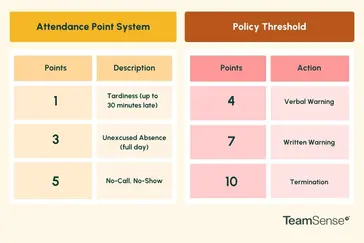
Sectors Well-Suited for an Employee Point System
An employee attendance point system is not right for every industry or sector, and before you spend your time deciding if this type of structured system is for your organization, it's crucial to understand where it fits best. This approach shines in environments where the consistency of staff presence is critical to daily operations.
It's particularly impactful in sectors where teamwork is at the core of productivity, and each member's role is interdependent, like in manufacturing, healthcare, or customer service. In these settings, a point system can significantly streamline management efforts, ensuring shifts run smoothly and service delivery meets the mark. Below is a list of sectors that could align with the benefits of an attendance and employee point system.
1. Retail and Hospitality: In these customer-facing industries, staffing levels directly impact service quality and customer satisfaction. A point system can help ensure that shifts are covered and reduce last-minute absences that strain remaining staff and degrade service.
2. Manufacturing and Warehousing: These sectors rely on precise schedules to maintain production lines and supply chain efficiency. Attendance policies can minimize disruptions caused by unscheduled employee absences, thereby maintaining productivity and safety standards.
3. Healthcare: Especially in non-clinical roles, point systems can help manage shifts in hospitals and clinics, ensuring that patient care areas are adequately staffed without overburdening other team members.
4. Education (Support Staff): For non-instructional staff, such systems can ensure that school operations are smoothly conducted, from maintenance to administration, supporting the educational environment without directly impacting classroom learning.
5. Entertainment and Amusement Sector: The entertainment and amusement industry, encompassing theme parks, casinos, sports venues (like baseball games), and resorts, is another prime candidate for the implementation of point system attendance policies. In these environments, managing employee attendance and presence is critical not just for operational efficiency but for guest satisfaction and safety.
Sectors Where an Employee Attendance Point System May Not Be Ideal
Just like any tool in the toolbox, an employee attendance point system has its specific use cases where it shines the brightest. However, there are sectors where its application might not align as well with the nature of work or the organizational culture. In creative fields, high autonomy roles, or industries where work output isn't directly tied to physical presence, a rigid point system could hinder more than help.
1. Creative Industries: In fields such as design, software development, and content creation, where output quality often trumps time spent at a desk, a rigid point system might stifle creativity and flexibility that these professions thrive on.
2. High-Level Professional Services: In sectors like law, finance, and consultancy, professionals often manage their schedules to meet client needs and project deadlines. A point system could undermine the trust and autonomy these roles require, potentially hampering client service and satisfaction.
3. Remote or Field-Based Work: For roles that are predominantly remote or involve fieldwork, such as sales or service technicians, attendance isn't about being at a specific place but rather meeting targets and completing tasks. A point system based on physical presence doesn’t align with the nature of these jobs.
4. Academia and Research: Academic and research positions often require flexibility for deep work, experimentation, and irregular hours spent on research, teaching, and scholarly activities. A point system might not adequately accommodate the ebb and flow of academic workloads and deadlines.
If you come to the conclusion that a points system is not a good fit a standard attendance policy may be all you need!
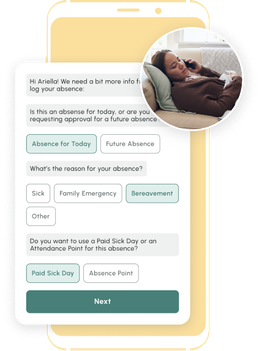
No one wants to talk to their boss or a 1-800 stranger to call off. Text changes everything - Reducing No Call No Shows.
The Evolution of Attendance Tracking Technologies
Gone are the days of punch cards and sign-in sheets, relics of a bygone era. Today's attendance tracking has embraced the digital revolution. From biometric systems that recognize faces or fingerprints to mobile apps that clock in with a tap, technology has redefined presence. These innovations offer real-time tracking, reduce errors, and even adapt to remote workforces. But it's not just about logging hours; it's about integrating with broader HR systems to analyze trends, predict needs, and enhance overall workforce management.
Why Implement a Point System in 2025?
As we gaze into the future, the question looms: Why is 2025 the year for your business to adopt a point system? The answer lies in the shifting sands of the workplace. With a greater emphasis on work-life balance, employee accountability, and good attendance habits, traditional attendance policies struggle to keep pace. A point system offers flexibility, adapting to diverse work environments while maintaining accountability. It speaks the language of today's workforce, prioritizing transparency and fairness. Implementing such an employee point system now prepares your organization for tomorrow, ensuring that your attendance policy is as dynamic and adaptable as the market in which you operate.
The Benefits and Challenges of Point System Attendance Policies
The dance between managing attendance effectively and maintaining a happy workforce can be as delicate as it is crucial. Point system attendance policies, when implemented thoughtfully, can strike this balance. Let's take a look at the harmony and occasional discord these attendance point systems bring to the workplace.
Benefits of Using a Point System
Fairness and Equality: One of the most significant advantages of a point system is its ability to level the playing field. Every employee, regardless of rank or tenure, is subject to the same rules and consequences. This transparency eliminates perceptions of favoritism and bias, fostering a culture of fairness.
Simplicity in Management: The beauty of a point system lies in its simplicity. Clear guidelines mean that employees understand exactly what is expected of them and the repercussions of not meeting those expectations. This clarity reduces confusion and simplifies the role of managers in monitoring and enforcing attendance policies.
Technology-Enhanced Implementation: Enter TeamSense, an attendance-tracking software that streamlines the operational aspect of point systems. With its intuitive call-off system, TeamSense allows for easy tracking of attendance infractions, the system ensures timely communication with employees, and real-time notifications for managers and supervisors. This integration of technology not only makes implementation smoother but also enhances the overall effectiveness of a points-based policy.
Potential Challenges and Solutions
While the point system has its merits, it's not without its hurdles. Recognizing these potential pitfalls is the first step towards navigating them successfully.
Risk of Rigidity: One common critique is that point systems can be too rigid, not accounting for individual circumstances or emergencies. This rigidity can lead to employee dissatisfaction and demoralization.
Potential for Miscommunication: As with any policy, the risk of miscommunication or misunderstanding the rules is ever-present. Poorly communicated policies can lead to unnecessary conflicts and grievances.
What's nice about TeamSense is that it addresses this challenge head-on by providing a clear, direct line of communication between managers and employees. Through the platform, policies are clearly outlined, points balances are shown before an absence is sent in, and any updates or changes can be instantly communicated, ensuring everyone is on the same page.
Employee Pushback: Change is often met with resistance, and the introduction of a point system can be no exception. Employees may view the new policy as punitive or distrust its intentions.
Planning Your Point System Attendance Policy
Writing a point system attendance policy is more than setting rules—it’s about creating a structure that supports your company’s culture, goals, and legal obligations. It requires thoughtful planning and a clear understanding of what you aim to achieve and the legal landscape you operate within.
Setting Clear Objectives
Before diving into the logistics of a point system, it’s crucial to outline what you hope to accomplish. Objectives might include reducing unscheduled or frequent absences, improving overall productivity, or enhancing fairness in how attendance issues are managed. Whatever your goals, they should align with your company’s broader objectives and culture. Clear objectives not only guide the development of your policy but also help communicate its purpose and benefits to your employees, fostering a sense of transparency and buy-in.
Identify Key Metrics for Success: Decide on the metrics you’ll use to evaluate the effectiveness of your point system. Whether it's a reduction in absenteeism rates, an improvement in employee satisfaction scores, or a decrease in turnover, having concrete metrics will help you assess the policy’s impact.
Employee Engagement: Consider how the policy will affect your workforce. Engagement strategies, such as soliciting feedback through surveys or focus groups, can provide invaluable insights that shape a more effective and accepted policy.
Navigating Legal Considerations
With point-based attendance policies, legal adherence is not just a good practice—it's a necessity. As you draft your points policy, it’s paramount to consider the various legal landscapes that govern employee rights and employer responsibilities. This ensures your policy not only promotes fairness and productivity but also aligns with federal and state regulations, safeguarding against potential legal pitfalls.
Understand Applicable Laws: A thorough understanding of relevant labor laws is crucial. This includes, but is not limited to, the Americans with Disabilities Act (ADA), the Family and Medical Leave Act (FMLA), and state-specific leave laws. These regulations often dictate necessary exceptions to standard attendance policies, such as accommodations for employees with disabilities or those requiring family or medical leave.
Crafting a Compliant Policy: Your policy must reflect these legal requirements, incorporating clear guidelines for exceptions and accommodations. It’s essential to outline how the policy applies to various scenarios protected under law, ensuring that all employees are treated fairly and that the policy is applied consistently.
Documentation and Communication are Key: Effective documentation and clear communication of your attendance policy play critical roles in legal compliance. Ensure that your policy is accessible to all employees, detailing the provisions for legally protected absences and the process for reporting and documenting such absences.
Periodic Review and Update: Laws and regulations change, and so should your attendance policy. Regularly review and update your policy to reflect current laws and best practices. This not only helps in maintaining legal compliance but also reinforces your commitment to a fair and respectful workplace.
Navigating legal considerations is a delicate process that requires a balance between enforcing attendance policies and respecting employee rights. By prioritizing legal compliance and clear communication, you can develop a point system attendance policy that supports your organizational goals while fostering a positive and lawful work environment.

Different Approaches to Rolling out a Point-Based Attendance Policy to Employees
Implementing a new policy within an organization can be approached in several ways, each with its own set of advantages and potential drawbacks. Here are some common strategies and their pros and cons:
Gradual Implementation
Pros:
- Allows time for adjustments based on feedback.
- Employees experience less shock to change, easing transition.
- Issues can be addressed on a smaller scale before wide adoption.
Cons:
- Can be slow to see company-wide results.
- May lead to temporary inconsistencies across departments.
- Could result in prolonged periods of adjustment.
All-at-Once Implementation
Pros:
- Quick to establish new norms across the entire company.
- Everyone is on the same page, reducing confusion about policies.
- Potential issues are identified and resolved more rapidly at scale.
Cons:
- Can be overwhelming for employees and management.
- Greater risk of widespread issues that can be harder to pinpoint and resolve.
- May lead to resistance or pushback if change is too abrupt.
Phased Implementation by Department or Role
Pros:
- The tailored approach allows for customization based on department needs.
- Managers can provide more focused support to their teams.
- Reduces the burden on HR and administrative resources at any one time.
Cons:
- Can create a sense of inequality or confusion among employees.
- Coordinating between different departments on policy application can be complex.
- May lead to fragmented data on policy effectiveness.
Implementation with Pilot Groups
Pros:
- Feedback from pilot groups can inform policy adjustments.
- Allows for a test case to measure potential success.
- Minimizes risk by limiting the initial scope of implementation.
Cons:
- Success in a pilot group doesn’t guarantee company-wide success.
- Pilot groups may not represent the diversity of the whole company.
- Can delay full policy benefits until after pilot testing and adjustments.
When considering these approaches, it’s crucial to evaluate your organization's readiness for change, the complexity of the new policy, and the resources available to support implementation. Regular communication, training sessions, and a clear understanding of the rationale behind the policy change can mitigate many of the cons listed above, regardless of the approach chosen.
Tracking Attendance Points Once The Policy Is Set
Tracking attendance points is a key component of maintaining an effective attendance policy. There are multiple ways to track these points, and the choice of method can depend on the size of your organization, the complexity of your attendance policy, and your technological capabilities.
Traditional Methods:
Paper Records or Spreadsheets:
- Some smaller businesses or those preferring low-tech solutions might opt for manual attendance tracking.
- Pros: Simple to implement with no need for specialized software.
- Cons: Time-consuming, prone to human error, and challenging to scale.
Time Clocks with Point Tracking:
- Physical or digital time clocks can often be programmed to track attendance infractions and assign points automatically.
- Pros: Efficient and provides a time-stamped record of attendance.
- Cons: May not offer the flexibility needed for nuanced point systems or complex shift patterns.
HR Software Systems:
- Many HR software systems include modules for attendance tracking and can be customized to track points.
- Pros: Integrates with other HR functions like payroll and performance management.
- Cons: Can be expensive and may require training to use effectively.
Innovative Approach with TeamSense:
- An innovative, tech-forward approach to tracking attendance points via text for complete transparency.
- Pros: Offers real-time updates, accessible from any device with internet connectivity. TeamSense provides transparency, allowing both employees and managers to viewpoint totals at any time. This approach reduces disputes and confusion over attendance records.
- Cons: Reliance on digital literacy; requires that all staff members have access to the necessary technology.
Highlight on Transparency with TeamSense:
Transparency in attendance tracking is vital for employee trust and buy-in. TeamSense elevates transparency by giving employees immediate access to their attendance records and point totals. It ensures that any points accrued are communicated clearly and promptly, minimizing the potential for misunderstandings or grievances.
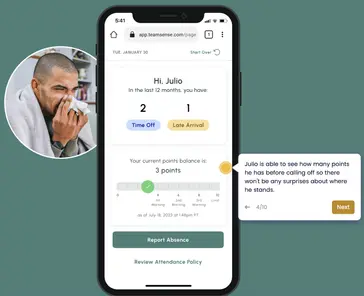
Moreover, TeamSense's interface can be more user-friendly and engaging than traditional systems, which might use complex spreadsheets or paperwork that can be daunting for some employees to understand or access.
In essence, TeamSense represents a new wave of workplace technology that prioritizes clarity, ease of use, and accessibility—traits that are invaluable in fostering an organizational culture that values fairness and transparency. This can lead to higher levels of employee engagement and compliance with attendance policies, as employees feel more in control and informed about their standing.
In choosing the right method to track attendance points, consider factors such as the size of your workforce, the complexity of your attendance point policy system, the need for real-time tracking, and the importance of transparency to your organizational culture. TeamSense stands out as a solution that checks many of these boxes, particularly for organizations looking to modernize their attendance tracking and enhance transparency.
Launching a Pilot Phase
Before fully implementing the new point system policy, consider a pilot phase. Select a single department or team and implement the point system there first. This allows you to identify any hiccups and gather feedback before rolling it out company-wide. During this phase, communication is key—keep the lines open with TeamSense’s platform to promptly address questions and concerns.
Leveraging TeamSense for Attendance Tracking and Management
TeamSense stands out for its user-friendly attendance tracking and management capabilities. The platform allows for real-time updates on attendance infractions, which means managers and employees alike have immediate insight into current point totals. Integration with your existing HR systems is streamlined, ensuring that employee attendance data feeds directly into your payroll and performance management systems.
Key Features:
- Automated Alerts: Notify managers of point accruals and approaching thresholds.
- Employee Self-Service: Team members can check their current points and understand potential consequences.
- Documentation and Record Keeping: All attendance records are maintained within the platform for easy access during audits or disputes.
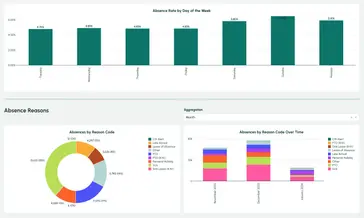
Monitoring, Evaluation, and Making Data-Driven Decisions
Continuous improvement is part of TeamSense’s ethos, supported by robust analytics and reporting features. Utilize the platform's data insights to monitor attendance trends, evaluate the effectiveness of your point system, and make informed decisions. This could mean adjusting point thresholds, fine-tuning consequences, or identifying departments that may need additional support or resources.
Analytics for Strategy:
- Trend Analysis: Understand attendance patterns over time to forecast staffing needs.
- Policy Impact Assessment: Gauge how changes to the policy affect absenteeism rates.
- Employee Feedback Integration: Incorporate employee feedback into the data analysis to ensure the policy is fair and effective.
By taking these steps and utilizing TeamSense’s comprehensive suite of tools, you're positioning your point system policy not just as a set of rules, but as a dynamic part of your organization's culture and strategy.
How to Write Your Point System Attendance Policy
Writing an effective point system attendance policy involves more than just assigning points for absences. It requires a thoughtful approach to configuration, an understanding of the balance between discipline and motivation, and clear communication strategies. Let's explore the key components of designing a policy that enhances workplace productivity and fairness.
Configuring Points for Different Absences
Varied Weight for Different Offenses: Not all absences are created equal. Late arrivals might incur fewer points than a no-call, no-show, for example. Establishing a scale that reflects the severity of different types of absences can help in applying the policy fairly and consistently.
Considerations for Accumulation and Expiration: Determine how long points stay on an employee's record before they expire or are reset. This aspect of the policy can help prevent long-term penalization for short-term issues, allowing employees to recover their standing within the company.
Special Circumstances and Exceptions: Account for legally protected absences (like jury duty or FMLA leave) and unexpected family emergencies. Providing clear guidelines for these exceptions ensures compliance and fairness.
Establishing Consequences and Rewards
Progressive Discipline: A structured approach to consequences helps employees understand the potential impact of their absences. From verbal warnings to written notices and ultimately, even termination, each level of disciplinary action should correspond with the accumulation of points to ensure transparency.
Rewards for Good Attendance: Incorporating positive reinforcement can significantly enhance the effectiveness of your attendance policy. Consider rewards like additional paid time off, public recognition, or even small bonuses for employees who maintain excellent and consistent attendance records.
Balancing Consequences and Rewards: The key to a successful point system is finding the right balance between discouraging unwanted behavior and encouraging desired behavior. This balance can help foster a positive work environment and motivate employees to adhere to attendance policies.
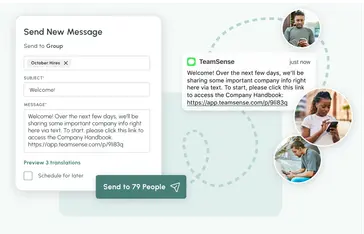
Effective Communication and Implementation
Clearly documented policies are essential for successful implementation. Ensure your attendance policy is accessible to all employees and includes comprehensive details on point allocation, consequences, rewards, and the process for logging and disputing absences.
Educating your workforce about the new policy is crucial. Hold training sessions to walk through the policy details, focusing on the rationale behind the point system and how it benefits both the company and its employees.
After implementation, solicit feedback from employees and managers via pulse surveys and forms about how the policy is working in practice. Be open to making adjustments based on this feedback to ensure the policy meets its objectives and remains fair and effective.
Designing your point system attendance policy with these elements in mind can help ensure it is fair, transparent, and effective. By clearly defining absences, establishing a balance of consequences and rewards, and maintaining open lines of communication, your point system can become a valuable tool in managing attendance and enhancing workplace culture.
Example of a Point System Attendance Policy
I. Purpose & Scope
State the overall purpose of your attendance policy and who it applies to. For example: “This attendance policy aims to manage proper operations, increase productivity, and foster a supportive work environment by encouraging regular and punctual attendance among all employees.”
II. Definitions
Next, include all your required definitions, including:
a. Absence: An absence refers to any occasion when an employee does not report for their scheduled work shift.
b. Excused Absence: Excused absences are when employees miss work for a valid and usually pre-approved reason such as personal illness, family emergency, or jury duty.
c. Unexcused Absence: An unexcused absence occurs when an employee misses work without a valid reason or prior approval from their supervisor.
d. Excessive Absenteeism: This term describes when an employee's rate of absence exceeds the standard or acceptable amount as defined by the company's attendance policy.
e. Tardiness: This happens when an employee arrives later than their scheduled work shift or returns late from a break.
f. Early Departure: Early departure takes place when an employee leaves work before the end of their scheduled shift without pre-approval.
g. Job Abandonment: Job abandonment is when an employee fails to report to work for consecutive days without notifying their supervisor or seeking approval.
h. Paid Time Off (PTO): This policy allows employees to accrue hours they can use to take time off work and still receive their regular pay.
i. Leave of Absence: A leave of absence is an extended period of time off work, granted by the employer, which could be paid or unpaid.
j. No-Call, No-Show: This refers to instances where an employee fails to show up for their scheduled shift without informing their supervisor.
k. Flextime: A flexible hours policy that allows employees to start and end their workday at varying times while still working the required number of hours.
Remember, your specific definitions may need to adjust to fit your company's policies or practices.
III. Absence Reporting & Time Off Requests
Make sure to include how attendance and sick leave will be reported and tracked. Something like: “Employees are required to report absences to [designated person/department] using [specific method], at least [timeframe] consecutive days before their scheduled shift start time.”
Other things to consider talking about in this section include:
Absence Reporting
If an employee cannot report to work due to illness or any other reason, they should notify their supervisor as soon as possible. Preferably, this notification should occur at least one hour before the start of their shift, or according to your specific company policy. Employees should provide a reason for the absence and, if possible, the expected duration.
Procedure for Planned Absences
For planned absences, such as personal days or vacation time, employees should submit a time off request to their supervisor in advance. The time frame for such requests should be specified in the policy (e.g., two weeks in advance for vacation days). All requests are subject to approval based on operational needs.
Procedure for Unplanned Absences
In the case of unexpected absences, such as sudden illness, employees should contact their supervisor or designated contact person as soon as possible and no later than the start time of their shift. The company may require a doctor's note or other documentation for absences due to illness, in accordance with applicable laws.
Extended Absences
In the case of extended absences, employees may be required to provide additional documentation, such as a doctor's note, and may need to take leave in accordance with FMLA or other relevant leave policies.
Time Off Requests
Time off requests should be submitted through the company's designated system, whether it's a digital platform, email, or paper form. The request should include the type of leave being requested (e.g., vacation, personal), the start and end date of the leave, and any other necessary information.
Approvals for time off are based on a variety of factors, including the operational needs of the business and the employee's available leave balance. Once a request is reviewed, the employee will be notified of the approval or denial of their request.
Remember, the purpose of this section of the policy is to clearly communicate expectations and procedures around reporting absences and requesting time off. This not only helps the organization manage staffing and boost productivity, but also ensures employees understand their responsibilities in maintaining regular attendance and timely reporting.
IV. Attendance Points Policy
Our point system approach to attendance involves assigning points or demerits for different types of absences, tardiness, or early departures. Employees accumulate points for each infraction. When an employee reaches a certain point threshold, disciplinary action is taken.
Point Allocation:
- Tardiness (up to 30 minutes late): 1 point.
- Leaving Early (without authorization): 1 point.
- Unexcused Absence (full day): 3 points.
- No-Call, No-Show: 5 points.
- Excused Absences (with documentation): 0 points.
Point Expiration: Points are designed to expire, removing themselves from an employee's record 12 months after the calendar year they are recorded. This allows employees to recover and improve their attendance history over time.
V. Consequences for Policy Violations
In any well-crafted employee attendance policy, it is essential to outline the consequences of policy violations. A clear system of the progressive discipline process helps employees understand the seriousness of attendance issues and the various disciplinary actions that will be taken if their attendance does not improve. Here's how you could structure it:
1. Verbal Warning - 4 points
During a one-on-one meeting, the supervisor should explain the infraction, emphasize the importance of regular attendance, and discuss ways to improve. The conversation should be documented in the employee's file.
2. Written Warning - 7 points
This written documentation should outline the nature of the attendance issue, previous discussions about the problem, and steps the employee needs to take to improve.
3. Final Written Warning - 9 points
This should include a summary of past written warnings, a clear description of the problem, and a final opportunity for the employee to correct their attendance. The warning should also include a note that further infractions could lead to more severe consequences, including termination.
4. Suspension or Termination - 10 points
In cases of excessive absenteeism or tardiness, or if previous warnings have not resulted in improvement, more severe action may be necessary. This disciplinary action could be unpaid suspension or, in the most severe cases, termination of employment.
5. Appeal Process
It's also important to include an appeal process in your attendance policy. This allows employees to dispute attendance violations if they believe they were incorrectly applied or in case of extenuating circumstances.
Remember, every situation is unique, and disciplinary measures should be appropriate to the severity and frequency of the infractions. Always seek legal counsel when drafting or revising disciplinary procedures to ensure they comply with local labor laws and regulations.
VI. Support and Accommodations
When drafting an attendance policy, it's important to take into account the need for support and accommodations. Let's explore how these can be integrated into your policy:
1. Support for Employees with Disabilities
The Americans with Disabilities Act (ADA) requires employers to provide reasonable accommodations for employees with disabilities. This could include a modified work schedule, additional breaks, or a work-from-home arrangement. Your policy should make it clear that such accommodations will be considered on a case-by-case basis, in accordance with the law, and with the input of the employee and their healthcare provider.
2. Religious Observances
Title VII of the Civil Rights Act of 1964 requires employers to reasonably accommodate employees' sincerely held religious beliefs, unless doing so would impose an undue hardship on the employer. Accommodations could include flexible scheduling, voluntary shift substitutions or swaps, job reassignments, or modifications to workplace policies or practices.
3. Employee Assistance Programs (EAPs)
Many organizations offer Employee Assistance Programs (EAPs) to support employees who are dealing with personal issues that may impact their attendance or job performance. These programs can provide resources for handling stress, mental health issues, substance abuse, and other personal concerns.
4. Work-From-Home or Flexible Scheduling Policies
For some employees, flexible scheduling or the ability to work from home on occasion may be the support they need to balance work with personal responsibilities. If your organization offers these options, they should be mentioned in the attendance policy, along with details about who qualifies for them and how to request them.
5. Medical or Family Leave
Your policy should reference the Family and Medical Leave Act (FMLA), which allows eligible employees to take unpaid, job-protected leave for specified family and medical reasons. If your company offers any additional paid or unpaid leave options, these should also be included.
In all cases, your policy should direct employees to the appropriate human resources contact or department for questions or requests related to these accommodations and support programs.
Include details about available human resources and, support programs, or accommodations for employees with disabilities, religious observances, or other special circumstances.
VII. Policy Review and Updates
Indicate how often the policy will be reviewed and updated, and how changes will be communicated to employees
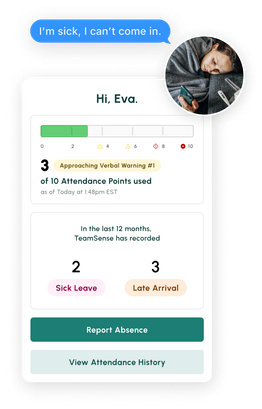
Managing and Refining Your Policy Over Time
Implementing a point system attendance policy is just the beginning. To ensure it remains effective and fair, it's important to manage and refine the policy over time, responding to the evolving needs of your organization and your workforce.
Encouraging Feedback and Engagement
To foster a culture of continuous improvement, actively seek feedback from your employees about the attendance policy. Create channels for employees to express their opinions and suggestions safely and anonymously if they choose. This feedback is invaluable; it can provide insights into how the policy affects day-to-day operations, performance reviews and employee morale. Regular surveys, focus groups, or suggestion boxes can be effective tools for gathering this information.
Engagement doesn't end with gathering feedback; it also involves acting on it. Keep the lines of communication open by discussing feedback during team meetings and sharing what actions will be taken as a result. This transparency shows employees that their input is not only welcomed but also valued and taken seriously.
Iterative Adjustments for Continuous Improvement
Your point system policy should be a living document, adaptable to the changing needs of your organization. Based on the feedback and data collected, make regular adjustments to refine the policy. This might involve tweaking point thresholds, updating consequences, or altering how points are assigned for different infractions.
Consider implementing a regular review cycle for the policy—perhaps annually or biannually—to ensure that it remains up-to-date with any changes in labor laws, company goals, or workforce structure. This also presents an opportunity to reassess the tools and software you use to support the policy, ensuring they continue to meet your needs effectively.
The Role of TeamSense in Modernizing Attendance Policies
The integration of TeamSense into your attendance policy modernization efforts signifies a step towards a more connected, efficient, and transparent workplace. TeamSense's role transcends mere attendance tracking; it becomes a pivotal tool in enhancing communication, fairness, and strategic decision-making.
Key Points of TeamSense’s Role:
- Real-Time Tracking and Communication: TeamSense provides an accessible platform for real-time updates on attendance, ensuring employees and managers are always informed.
- Transparency and Fairness: With immediate access to attendance data, employees can see where they stand, fostering a culture of trust and openness.
- User-Friendly Interface: The simplicity of TeamSense’s design encourages greater engagement and compliance from employees, removing barriers to adoption and utilization.
- Adaptability and Customization: TeamSense offers customizable features that can be tailored to fit the unique requirements of different workplaces, making it a versatile option for policy implementation.
- Data Analytics for Informed Decisions: The platform's analytics capabilities provide valuable insights, allowing for data-driven adjustments to the attendance policy over time.
- Legal Compliance: TeamSense aids in navigating the complexities of labor laws, offering features that help ensure your attendance policy remains compliant.
In a landscape where the right technology can drive success, TeamSense stands out for its ability to adapt to the needs of a modern workforce. By selecting TeamSense, organizations can look forward to not just a digital transformation of their attendance systems, but also an enhancement of their overall operational effectiveness.
About the Author

Jackie Jones, Employee Engagement & Attendance Specialist
Jackie Jones has over three years of experience helping HR teams improve employee morale, reduce absenteeism, and create happier, more engaged workplaces. With a strong background in employee relations and attendance management, she brings practical strategies and insights that support frontline teams and the HR professionals who lead them.
